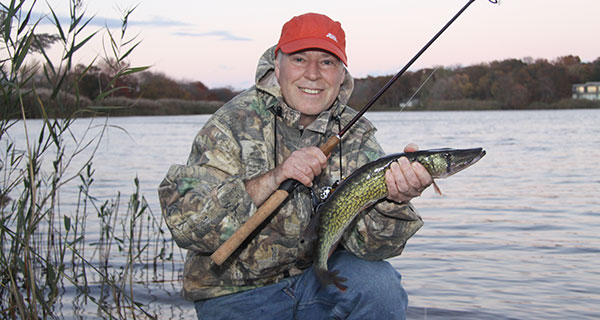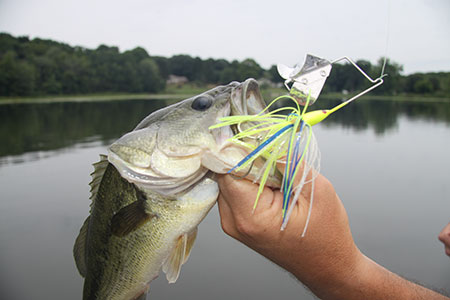
By Tom Schlichter
With all the anticipation of the fall run of stripers, bluefish and false albacore that light up the salty shores of Long Island Connecticut and Rhode Island during September, October and November, it’s no wonder many freshwater lakes and ponds go virtually untouched at this time of year. To be sure, I get in my fair share of action in the briny, but it’s also during this period that I hook-up with some of my biggest largemouth bass and pickerel of the season while enjoying being the only boat on the water.
While many sweet water fans realize that there is a fall run on local lakes and ponds, few understand that it starts a sooner and finishes earlier than the saltwater runs. Mid- September through early October is prime time on most of our shallow lakes and ponds as water temperatures have already been decreasing slowly but steadily since late August. Wait too long to make your move and you’ll be fishing for bass that have taken up more of a winter pattern than a fall binge feeding spree.
BIG PROFILES

They’ll be plenty of time to continue fishing for typical-sized bass and picks after the fall binge, but the peak period when the big ones come out to play is indeed a short one. Some years it only lasts ten days, although two or three weeks is more generally the case. During this brief period, I put away the surface poppers, move off the banks and break out some big, slow moving lures. I’m looking to tangle with one or two big fish per trip at this point in time; a bucketmouth that might tip the scales at 6 or 7 pounds or a pickerel that stretches the tape 26 inches or more.
One of my favorite lure types for fall’s binge-feeding trophies are large spinnerbaits. A 1/2-ounce green Strike King is my traditional go-to fall run spinnerbait, although I’ll sometimes toss a bright white Terminator Super Stainless Spinnerbait under cloudy skies or when working structure in water deeper than six or seven feet. These I’ll slow-roll over any stumps or sunken structure I can find. Large spinnerbaits are also great for probing rubble on the bottom in eight to 12 feet of water, ideally where sand and mud bottoms meet. The key with these lures is to keep the retrieve slow, but always have the blades spinning. You want the lure to present a large target that is barely making headway. Strike hard and instantly at any bump you feel – even if working around heavy structure.
LONG WORMS WORK WONDERS

Another lure that turns the heads of big fish looking to beef up for winter is a large, scented or flavored plastic worm. Put away the small, 3-, 4- and even 6-inch versions and step up to a 7, 8, or 10-inch worm with some heft and visibility. Berkley’s Soft Power Worm in black, motor oil or blue fleck color patterns works well, as does a 10.5-inch Zoom ‘Ol Monster Worm in purple.
Rig these weedless-style and toss either along the deep end of a downfall. Drag them gently up through the branches and pause for just a second before setting the hook if you feel a pick-up or see the line twitch. If you know of any deep holes in the eight to 14-foot range, toss a worm to the far side and retrieve by gently lifting your rod tip enough to glide the lure a foot or two above the bottom before letting it settle to sit still for several seconds on a slack line. This year I plan to go even bigger in the soft plastic department, trying my luck with something a little more chunky like a 10-inch Original Hogy or 12-inch Slug-Go generally reserve for striper fishing around rocks and boulders in our area.
STICK IT TO ‘EM
If we are lucky enough to get a shot of Indian Summer, large hard plastic minnow imitations can also produce at this time of year. On those days when the sun warms the surface just a little bit, I like to toss 5- to 7-inch floating Rapalas – or even the wider profile Bombers – when I’m working open waters. These will sometimes generate a little action with 2- to 4-pound fish – but every once in a while they stick a good one. In fact, several years ago, I caught and released a skinny 6.5-pound hawg on Lily Lake on Long Island by working a 5-1/4-inch Rapala Original Floating Minnow along the back edge of a dying lily set.
After looking down the throat of that monster as I reached in to grasp the head of my lure, I came away with one unshakeable thought: that fish could have easily crushed an offering twice the size of the lure I was tossing.









